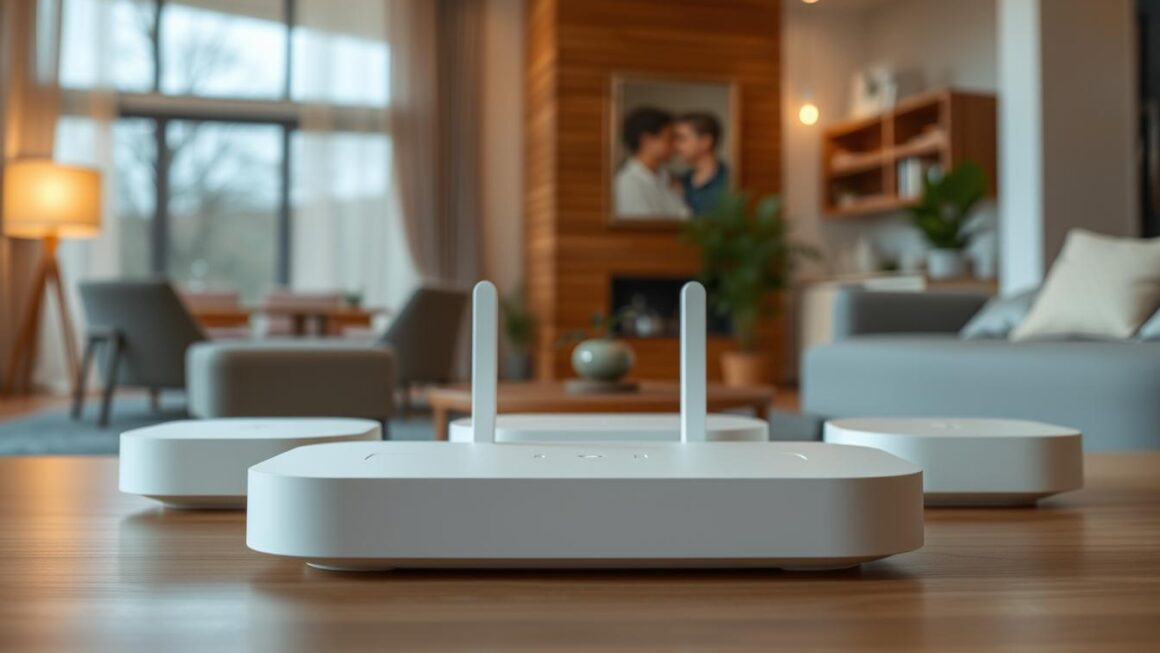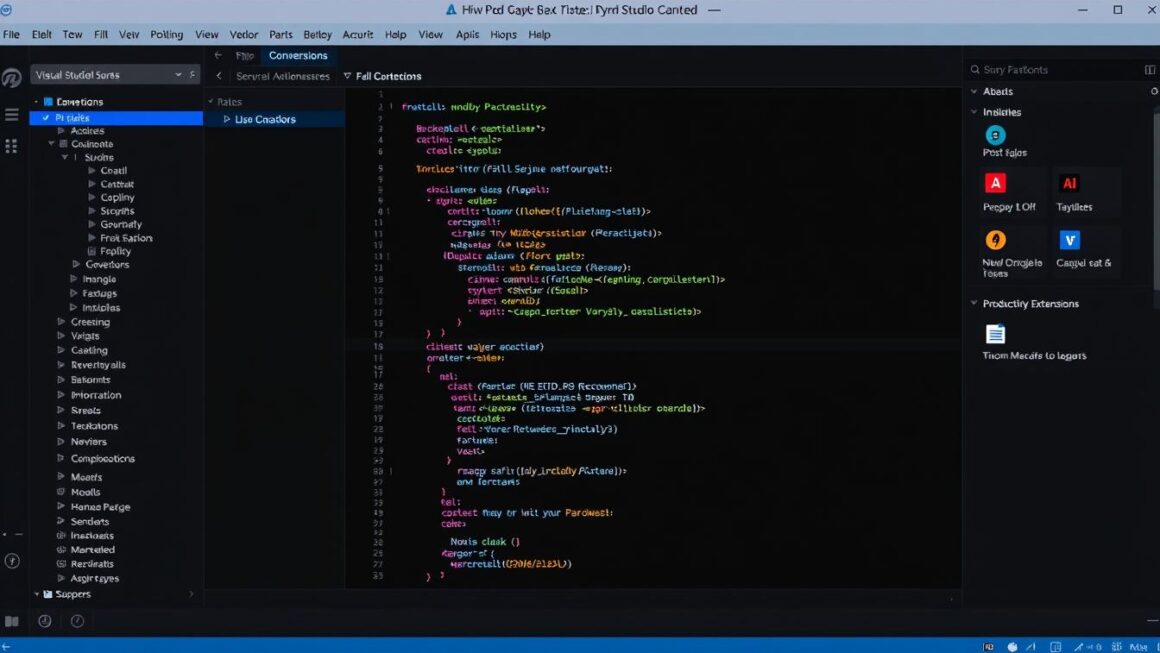Did you know that nearly 70% of households in the United States face Wi-Fi dead zones? This problem is big in homes with multiple stories. A single router can’t cover the whole house well.
We need a strong internet connection for streaming, gaming, and working from home. Mesh WiFi systems are a game-changer. They use many nodes to give fast Wi-Fi everywhere in the house.
Mesh networks are different from old routers. They offer a strong and smooth connection. This makes them a great home internet upgrade for those who hate buffering and dropped signals.
Key Takeaways
- Mesh WiFi systems provide complete coverage for big homes.
- They get rid of Wi-Fi dead zones and keep your connection stable.
- Many nodes work together to bring fast internet.
- Perfect for homes with lots of devices and heavy internet use.
- It’s a big step up from using just one router.
The Changing Landscape of Home Internet
Our need for digital connection is growing fast. With more remote work, online gaming, and smart devices, we need strong, reliable internet at home. This is more important than ever.
Growing Connectivity Demands
Our homes are filled with devices like smartphones, laptops, smart TVs, and gaming consoles. Most homes now have many devices online at the same time. This means we need a network that can handle the load without slowing down.
Why Traditional Routers Fall Short
Traditional routers often can’t cover large homes or those with many floors well. . Moving to a mesh WiFi system can solve these problems by giving a strong, reliable connection everywhere.
Traditional routers have limited range and can’t handle many devices well. Mesh WiFi systems, on the other hand, are great for wireless home networking. They make sure you have a smooth internet experience on all your devices.
- Improved coverage and reliability
- Support for multiple devices
- Enhanced overall network performance
What Are Mesh Networks and How Do They Work?
Understanding mesh networks is key for better home internet. A mesh network has a main router and nodes for a single WiFi network. This setup makes sure devices connect to the strongest signal, improving signal strength and network performance.
The Technology Behind Mesh WiFi
The tech behind mesh WiFi is about nodes working together for a strong connection. Unlike single-device routers, mesh systems use many access points for full coverage.
Mesh vs. Traditional Routers vs. Extenders
Mesh networks differ from traditional routers and extenders in important ways. Traditional routers may not cover big homes well. Extenders can lower network speed by rebroadcasting the signal. But, mesh WiFi systems give a strong, seamless connection everywhere, without the problems of traditional solutions.
Key Benefits of Mesh WiFi Systems
Mesh WiFi systems have changed how we connect at home. They give full coverage and fix connectivity problems. These systems are perfect for today’s homes that need strong internet.
Elimination of Dead Zones
Mesh WiFi systems get rid of dead zones. Old routers can’t reach all parts of a home. But mesh systems use many nodes to cover every corner with a strong signal.
Seamless Roaming and Connection
Mesh WiFi systems also make sure you stay connected everywhere. As you move, your device finds the best signal. This is great for big homes or those with many floors.
Support for Multiple Connected Devices
With more smart devices, we need systems that handle many connections. Mesh WiFi systems can handle lots of devices without slowing down.
The Eero6 Plus is known for its fast speeds. It’s among the top in tests and offers good value. Mesh networks fix dead zones, support more devices, and make sure traffic flows well.
| Mesh WiFi System | Number of Devices Supported | Coverage Area | Speed |
|---|---|---|---|
| Google Nest WiFi | Up to 100 devices | Up to 6,600 sq. ft. | Up to 2 Gbps |
| Amazon Eero | Up to 128 devices | Up to 6,000 sq. ft. | Up to 1.9 Gbps |
| Netgear Orbi | Up to 250 devices | Up to 7,500 sq. ft. | Up to 3 Gbps |
Top Mesh Networks for Home Internet Upgrade
The best mesh networks for upgrading your home internet are a mix of performance, features, and price. When picking a mesh WiFi system, think about coverage, speed, setup ease, and device compatibility.
Google Nest WiFi
Google Nest WiFi is a robust mesh network solution with great coverage and seamless Google device integration. It’s easy to set up and has a user-friendly interface.
Pros
- Easy to set up and manage
- Excellent coverage and performance
- Integrates well with other Google devices
Cons
- Not the cheapest option available
- Limited customization options
Features
Google Nest WiFi offers fast speeds and reliable connectivity. It also has parental controls and network prioritization.
Amazon Eero
Overview
Amazon Eero is a popular mesh WiFi system known for its robust performance and Alexa integration. It’s perfect for those in the Amazon ecosystem.
Pros
- Excellent performance and coverage
- Easy integration with Alexa
- User-friendly app for management
Cons
- More expensive than some other options
- Some users find the app less intuitive
Features
Eero provides fast and reliable connectivity. It also has parental controls and network security.
Netgear Orbi
Overview
Netgear Orbi is a high-performance mesh network with excellent coverage and speed. It’s ideal for larger homes.
Pros
- Excellent coverage and performance
- Fast speeds
- Robust build quality
Cons
- Can be expensive, even for larger setups
- Some find the setup complex
Features
Netgear Orbi has advanced features like MU-MIMO technology and beamforming. It’s a top pick for high-performance mesh WiFi.
Setting Up Your Mesh Network: Easier Than You Think
Mesh WiFi systems are easy to use. They come with apps that help you set them up. These apps guide you through the whole process.
User-Friendly Apps and Interfaces
The Eero app makes setting up simple. It shows you connected devices and lets you pause the internet. It also helps you set up a guest network. These apps are made to be easy to use, so you can manage your network without trouble.
Optimal Node Placement Tips
To get the best coverage, place nodes right. Put the main node near your router. Make sure other nodes are in central spots. Don’t put nodes in corners or where things might block the signal.
Initial Configuration Best Practices
When you first set it up, follow the app’s instructions carefully. Change your network name and password. Also, set up any extra features you need.
| Mesh System | App Ease of Use | Node Placement Flexibility |
|---|---|---|
| Google Nest WiFi | High | Medium |
| Amazon Eero | High | High |
| Netgear Orbi | Medium | High |
By following these steps and tips, you can set up your mesh WiFi network smoothly. This will make your home internet experience better.
Design and Aesthetics: Why Mesh Systems Look Better

Mesh WiFi systems have changed home internet with their looks and performance. They are now a key part of upgrading our homes with the latest tech. Their design is a big deal now.
Modern Design Elements
Modern mesh WiFi systems stand out with their design. Brands like Google Nest WiFi have made devices that are both useful and good-looking. These devices fit well in any home decor because of their small size.
Blending with Home Decor
Mesh WiFi systems can easily fit into any room. For example, the Nest Wifi looks fine on a table or shelf. Its design is sleek and small, making it easy to place anywhere.
Some key design benefits of mesh WiFi systems include:
- A sleek and modern look that matches home decor
- Compact designs for easy placement
- A focus on simplicity to avoid clutter
Mesh WiFi systems like Google Nest WiFi offer a great solution for wireless home networking. They combine performance with style.
Ideal Scenarios for Mesh WiFi Implementation
Mesh WiFi is great in specific situations. It offers a strong and steady home internet upgrade. This boosts your network performance overall.
Large Multi-Story Homes
In big homes with many floors, old routers can’t cover well. Mesh networks are perfect here. They make sure every area gets a strong, clear signal.
Smart Home Setups
Mesh WiFi is key for homes with lots of smart devices. It gives enough bandwidth for all devices to work smoothly. This makes your smart home experience smooth.
Home Office Requirements
Remote work is becoming common. Home offices need fast, reliable internet for video calls and cloud work. Mesh WiFi systems meet these needs with their strong network performance.
| Scenario | Key Benefits | Mesh WiFi Advantage |
|---|---|---|
| Large Multi-Story Homes | Comprehensive coverage, reduced dead zones | Ensures strong signal on every floor |
| Smart Home Setups | Supports multiple devices, stable connections | Provides necessary bandwidth for smart devices |
| Home Offices | Reliable internet, fast data transfer | Enhances productivity with stable connections |
Getting a mesh WiFi system can greatly improve your home internet upgrade. You’ll see better network performance all over your home.
Advanced Features of Modern Mesh Systems
Modern mesh WiFi systems have evolved a lot. They now include advanced features that boost network performance and seamless connectivity. These features make networking safer, more efficient, and easier to use.
Parental Controls and Security
One major feature is strong parental controls and security. For example, the Asus ZenWiFi XT8 has AiProtection Pro. It includes anti-malware and parental controls from Trend Micro. This keeps your family’s online experience safe.
Smart Home Integration
Mesh systems also work well with smart home devices. This makes it simpler to manage your connected home. It leads to a more efficient smart home experience.
Traffic Prioritization and QoS
Another key feature is traffic prioritization and Quality of Service (QoS). It lets you set priorities for important apps and devices. This ensures your network runs smoothly and reliably.
| Feature | Description | Benefit |
|---|---|---|
| Parental Controls | Robust controls to manage access | Safe browsing for families |
| Smart Home Integration | Seamless integration with smart devices | Streamlined smart home management |
| Traffic Prioritization | Allocation of bandwidth to critical apps | Reliable and high-performance network |
These advanced features make modern mesh WiFi systems a complete solution for your home internet. They ensure seamless connectivity and optimal network performance.
Common Challenges and Troubleshooting

Exploring mesh WiFi, we face common issues. Mesh WiFi systems aim for reliable coverage but can have problems.
Connectivity Issues
Many users struggle with connectivity problems. These can stem from physical barriers, device interference, or wrong node placement. To boost signal strength, place nodes well and use system tools to fine-tune your network.
Firmware Updates
Keeping your network secure and fast requires regular updates. These updates fix bugs, enhance WiFi, and add new features. Always check for updates and follow the manufacturer’s guide for a smooth process.
Expanding Your System
As your needs grow, you might need to add to your mesh WiFi. Many systems, like Eero, make adding nodes easy. Just make sure new nodes fit well into your network for the best performance.
| Issue | Solution | Benefit |
|---|---|---|
| Connectivity Issues | Optimize node placement, use network analysis tools | Improved signal strength and coverage |
| Firmware Updates | Regularly check for and apply updates | Enhanced security and performance |
| System Expansion | Add compatible nodes, integrate properly | Seamless coverage expansion |
Cost Analysis: Is Mesh WiFi Worth the Investment?
Thinking about upgrading your home internet? You might wonder if mesh WiFi is a good choice. Mesh WiFi systems are popular for their strong coverage and reliable connection.
Initial Setup Costs
The cost to start using mesh WiFi varies a lot. It depends on the brand, model, and how many nodes you need. For example, the TP-Link Deco X20 is a budget-friendly Wi-Fi 6 mesh system. It offers good coverage and performance.
When figuring out the initial cost, think about your home’s size and how many devices you’ll connect.
Long-Term Benefits
Even though mesh WiFi starts with a big price tag, its long-term perks are worth it. You’ll see better network performance, fewer dead zones, and easy support for many devices.
Comparing Different Price Points
To decide if mesh WiFi is a good buy, look at different prices and what you get for them. Check out performance, features, and the brand’s reputation. Here’s a table comparing some top mesh WiFi systems:
| Mesh WiFi System | Initial Cost | Network Performance |
|---|---|---|
| Google Nest WiFi | $299 | Excellent |
| Amazon Eero | $229 | Very Good |
| Netgear Orbi | $349 | Excellent |
By looking at these details and comparing mesh WiFi systems, we can decide if it’s a smart choice for our home internet.
The Future of Mesh Networks and Home Connectivity
The future of home internet is closely tied to mesh network technology. As we ask more from our home networks, emerging technologies are key in their growth.
Emerging Technologies
Technologies like Wi-Fi6E and Wi-Fi7 promise to boost mesh network performance. They will offer faster speeds and handle more devices. These updates are vital for our homes’ growing tech needs.
Integration with WiFi6 and Beyond
Merging mesh networks with WiFi6 and future standards will ensure smooth, strong connections. This is key for tasks needing quick responses and lots of data.
Smart Home Evolution
As smart home tech advances, mesh networks will be vital for reliable, wide coverage. The table below shows how these trends affect mesh networks.
| Trend | Impact on Mesh Networks |
|---|---|
| Increased device density | Higher demand for robust connectivity |
| Smart home adoption | Need for reliable, whole-home coverage |
| Advancements in WiFi technology | Faster speeds and better performance |
By grasping these trends, we can get our home networks ready for the future. This ensures they stay fast, dependable, and safe.
Conclusion
Mesh WiFi systems are a strong choice for homes wanting reliable internet. They get rid of dead zones and support many devices. This makes our devices stay connected everywhere in the house.
The cost of mesh WiFi systems has dropped a lot. A few years back, they cost up to $500. Now, you can find them for about $200, making them more affordable for many people.
Mesh WiFi is set to become the standard for home internet. It offers seamless connectivity and strong network performance. It’s a great upgrade for homes needing a reliable internet connection.



